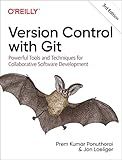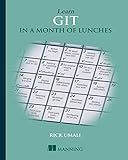Best Tools for Git Conflict Resolution to Buy in December 2025
When working collaboratively with others on a Git repository, it is common to encounter merge conflicts. These conflicts occur when two or more people make changes to the same file or lines of code at the same time. Resolving merge conflicts in Git involves the following steps:
- Identifying the conflict: Git will inform you about the conflicting files and the lines within them that have conflicts.
- Locating the conflict: Within the conflicting file, you'll find markers that indicate the conflicting areas. These markers typically look like "<<<<<<< HEAD", "=======", and ">>>>>>> branch-name".
- Understanding the conflict: Analyze the conflicting changes made by each person to understand the differences and potential solutions.
- Choosing the desired changes: Decide which changes to keep and which to discard. It can be your own changes, changes from the other collaborator, or a merged version of both.
- Removing the conflict markers: Delete the conflict markers from the file, including "<<<<<<< HEAD", "=======", and ">>>>>>> branch-name". Ensure that the file now represents the desired changes without any markers.
- Staging the resolved file: Use the "git add" command to stage the modified file after resolving the conflicts.
- Committing the changes: Create a new commit with a meaningful message explaining the merge resolution.
- Pushing the changes: If you were resolving conflicts in a branch other than the main branch, push the changes to the remote repository using the "git push" command.
By following these steps, you can successfully resolve merge conflicts in Git and maintain a clean and functional codebase when collaborating with others.
What is the role of Git's three-way merge in conflict resolution?
Git's three-way merge plays a crucial role in conflict resolution by combining changes from two different branches to create a new merged branch.
When merging branches in Git, conflicts can occur if the changes made in one branch conflict with the changes made in another branch. Git uses the three-way merge algorithm to analyze the differences between the two branches and their common ancestor, which is known as the merge base.
The three-way merge algorithm compares the changes made in each branch independently and then automatically combines these changes whenever possible. It considers the changes in the common ancestor as a reference point for determining how the conflicting changes should be merged.
In case of a conflict, Git identifies the conflicting sections in the code by comparing the changes made in the different branches. It then marks these conflicts in the affected files, allowing the developer to manually resolve them.
The three-way merge provides a structured approach to conflict resolution, taking into account the shared history of branches and the changes made in each branch, resulting in a more accurate and intelligent merging process.
How to resolve merge conflicts with binary files in Git?
Resolving merge conflicts with binary files in Git can be a bit more complex compared to resolving conflicts in text files. Here are the general steps to resolve merge conflicts with binary files:
- Before trying to merge the branches, make sure you have a backup of the binary file you are working with. This is important as resolving conflicts may involve manual changes.
- Start by running the merge command in Git (git merge branchname) to merge the branches. When conflicts occur, Git will notify you about the merge conflict and the affected binary file(s).
- Open the conflicted binary file(s) using a suitable binary file editor or viewer.
- Inspect the conflicting sections in the binary file. Git will insert conflict markers (<<<<<<<, =======, >>>>>>>) to highlight the conflicting sections. These markers show the conflicting changes from both branches. <<<<<<< HEAD // Changes from the current branch ======= // Changes from the other branch >>>>>>> branchname
- Determine how you want to resolve the conflict. This could involve manually editing the binary file to combine the changes from both branches, or discarding one set of changes in favor of the other.
- Make the necessary changes to resolve the conflict in the binary file, removing the conflict markers and keeping the desired changes. Take care not to corrupt the binary format.
- Save the modified binary file.
- Use the Git command git add filename to stage the resolved binary file.
- Once all conflicts are resolved and staged, complete the merge by running git commit. This will create a new merge commit with the resolved binary file.
Remember that binary files often don't merge as smoothly as text files, and conflicts may arise due to fundamental differences in structure or data. Having proper backup copies and understanding the internal structure of the binary file format can be helpful in resolving conflicts effectively.
How to resolve conflicting changes in Git?
To resolve conflicting changes in Git, follow these steps:
- Identify the conflicts: Run the command git status to see which files have conflicts. Conflicting changes are often indicated by a message that says "both modified."
- Open the conflicting file(s): Open each conflicted file in a text editor and locate the conflict markers. They usually look something like this:
<<<<<<< HEAD Code from the current branch
Code from the incoming/merged branch
branch_name
- Review the code: Examine the conflicting code and decide which changes should be kept. Edit the code so that it reflects the desired state.
- Remove the conflict markers: Delete the conflict markers (<<<<<<< HEAD, =======, and >>>>>>> branch_name) once you have resolved the conflict. Make sure to delete any unnecessary code or comments related to the conflict.
- Save the file: Save the changes in the file.
- Stage the resolved file: Run git add to stage the resolved file.
- Continue the merge process: After resolving conflicts in all files, run git commit to complete the merge commit. Git will automatically generate a commit message with details about the merge.
- Push the changes: If you are working in a shared repository, push the changes using git push.
Remember to communicate with your team members if you are resolving conflicts in a shared repository to ensure everyone is aware of the changes being merged.
How to use Git's mergetool to resolve conflicts with external tools?
To use Git's mergetool to resolve conflicts with external tools, follow these steps:
- Ensure that the external tool you want to use for merging is installed on your system and added to your PATH so that Git can detect it.
- Configure Git to use the desired external tool as the default mergetool. Run the following command in your terminal: git config --global merge.tool Replace with the name of the external tool. For example, if you want to use KDiff3, the command would be: git config --global merge.tool kdiff3
- Start the merge process using Git's regular merge command, which will automatically open the merge conflicts in the configured external tool. For example: git merge If there are conflicts, Git will open the external tool's interface with the conflicting files displayed.
- Use the external tool's interface to resolve the conflicts. The exact steps and interface will vary depending on the tool you're using. Refer to the documentation or help resources of the specific external tool for guidance on how to resolve conflicts.
- Once you have resolved the conflicts in the external tool, save the changes and close the tool.
- Return to the terminal where Git is running. Git will continue the merge process and ask you to confirm the resolution of each conflicted file. You can review the changes made by the external tool and confirm the resolution by typing :wq (or the appropriate save and exit command) in your terminal. Git will then proceed to the next conflicted file.
- After confirming the resolution for all conflicted files, Git will complete the merge process. Remember to commit the changes using git commit to finalize the merge.
Note: Take into account that the actual steps may vary depending on the specific external tool you are using. Refer to the documentation or help resources of the tool for more accurate instructions.
How to revert a merged file to a specific version in Git?
To revert a merged file to a specific version in Git, you can follow these steps:
- Identify the commit hash of the version you want to revert to. You can use git log or gitk to find the hash.
- Make sure you have a clean working directory by committing or stashing any changes you have.
- Use the following command to revert the specific file to the desired version: git checkout -- Replace with the commit hash of the version you want to revert to, and with the path to the file you want to revert. Example: git checkout abcdef1 -- path/to/file.extension
- The file will be reverted to the specific version you specified. Verify the changes using git diff and make further adjustments if required.
- Commit the changes using git commit to create a new commit with the reverted file.
Note: Reverting a file to a specific version will create a new commit that undoes the changes from the merged commit. It does not modify the history.
What is the impact of resolving merge conflicts on branch history in Git?
Resolving merge conflicts in Git has a direct impact on the branch history. When merge conflicts occur, Git requires the user to manually resolve the conflicts by editing the conflicting files. After resolving the conflicts, the user must commit the changes to complete the merge.
The commit that resolves the merge conflict becomes a part of the branch history. It acts as a new commit with the merged changes, incorporating both the changes from one branch and the changes from the other branch that caused the conflict.
The impact on the branch history includes:
- Additional commits: Resolving merge conflicts adds new commits to the branch. These commits represent the changes made to resolve the conflicts.
- Merge commit: Git creates a new commit known as a merge commit when merging conflicting branches. This commit contains metadata about the merge, such as the parent commits and the commit message.
- Clearing conflicts: Resolving merge conflicts ensures that conflicts are addressed within the branch history. It prevents conflicts from persisting and causing issues in future merges.
By resolving merge conflicts properly, the branch history reflects the successful merge of conflicting changes, providing a clear record of the merge process and preserving the integrity of the codebase.




